| |
Riparian Restoration at Veteran's Park
Before - March, 2000
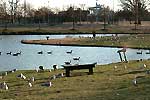 |
After - May, 2001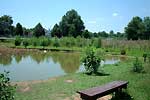 |
After - April, 2006
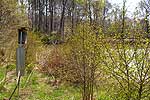
|
Before - March, 2000
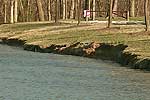 |
Just Finished - May, 2000
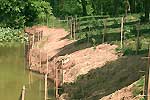 |
After - May, 2001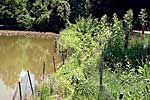
|
In May 2000, community volunteers, led by Julia Flanagan and Patty Dietz with Prince William County Watershed Management, restored the riparian buffer zone at a pond at Veteran's Park. This pond is surrounded by pavement on all four sides. Water quality was seriously degraded and the pond supported limited wildlife.
Volunteers replanted the buffer area and set in biologs to stablize the banks of the pond. It was a difficult job and people worked very hard. Their efforts paid off and this pond now attracts more wildlife, invites visitors to walk along its banks and improves the scenic appearance of Veteran's Park.
In our region undisturbed, healthy riparian zones are forested and have porous soils topped by organic leaf litter. The forest floor slows the storm water, which allows water to filter down into the soil where a rich system of microscopic and macroscopic life goes about purifying the storm water before it enters the ground water or stream.
WATERSHED
A watershed, or drainage basin, is the total land area that is drained through a network of tributaries into a main waterway. |
 Map of the Broad Run Watershed
Map of the Broad Run Watershed |
That's how it happens in nature. Unfortunately many of our streams, rivers and ponds have had the adjacent forest removed, often leaving grassy areas or even pavement behind.
At Veteran's Park a man-made stormwater pond surrounded by pavement on all four sides benefited from a Prince William County riparian restoration effort in spring, 2000. This particular pond leads directly to Marumsco Creek, a tributary to the Potomac River and Chesapeake Bay.
Before the restoration the pond buffer area consisted of grass. This stormwater runoff from the pavement that surrounds this pond on all four sides flows into the pond. Rain water picks up pollutants like oils, road salts, grit and trash and carries them into the pond. Grass does very little to help slow or filter stormwater and the pond was in rough shape before the restoration.
Another benefit of reforesting riparian zones is shade. Cool water temperatures are important for the quality of aquatic plant and animal life. When the area was grass there was no shade. As the new trees and shrubs grow, they provide increasing amounts of shade, cooling the water and improving the quality of aquatic habitats.
 By reforesting the area, volunteers improved the ability of this riparian zone to trap these pollutants and slow the velocity of water entering the pond. This improved the pond habitat, created a more scenic view and filters pollution from stormwater at Veteran's Park before it enters Marumsco Creek. By reforesting the area, volunteers improved the ability of this riparian zone to trap these pollutants and slow the velocity of water entering the pond. This improved the pond habitat, created a more scenic view and filters pollution from stormwater at Veteran's Park before it enters Marumsco Creek.
Volunteers worked very hard for many hours to make this restoration a success. Please respect their efforts and help protect this area from further degradation by keeping to paths, walking lightly, picking up any trash that you may see and not feeding geese (too many harm the pond and overwhelm other species).
back to top... |
|
| |
|
|
|
| Vocabulary |
RIPARIAN ZONE
The land immediately adjacent to a water body such as a stream, river, or pond. Rain that falls on adjacent land travels through a riparian zone on its way to the water body.
Riparian zones buffer non-point source pollution of waterways from adjacent land, reduce erosion, prevent flooding, protect aquatic and terrestrial habitats, and increase wildlife diversity.
Riparian areas create a scenic appearance and protect recreation opportunities for anglers, paddlers, wildlife watchers and others.
Forests are the most effective type of riparian buffer available.
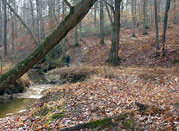
Riparian zone at the headwaters of Powell's Creek
January 7, 2005 |
|
Riparian Forest Buffers
Natural or re-established streamside forests made up of tree, shrub, and grass plantings.
Riparian buffers protect waterways from non-point source pollution from adjacent land, reduce erosion, prevent flooding, protect aquatic and terrestrial habitats, and increase wildlife diversity.
|
Volunteers work to replant the riparian buffer along an unnamed tributary to Neabsco Creek at Cloverdale Park in April, 2001. |
|
STORMWATER
Rainfall, snowmelt and water from other sources, such as overwatered lawns, that does not infiltrate into the soil.
Stormwater runs off ground surfaces and flows into gutters, streams, rivers and creeks, and eventually into the bays.
Stormwater carries contaminants such as plastic bags, detergents, nutrients and heavy metals into our waterways.

Stormwater draining off Route 1 just north of the confluence of Cow Branch and Neabsco Creek in April, 2005. |
|
|